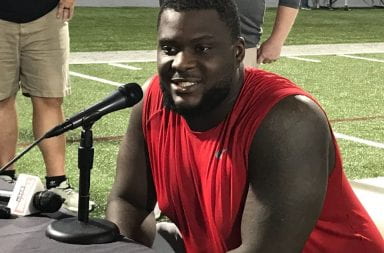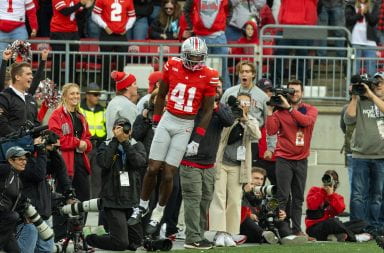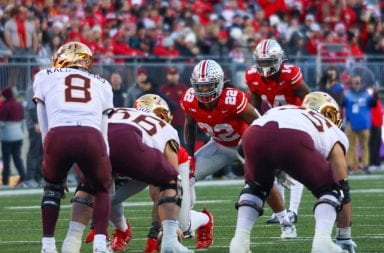
Ohio State co-offensive coordinator Kevin Wilson influencing running backs in first season in Columbus. Credit: Jacob Myers | Managing Editor for Content
Usually when a team returns a three-time captain and reigning Big Ten quarterback of the year, eight offensive starters and one of the game’s elite head coaches, there aren’t many questions pertaining to the effectiveness of the offense.
But that isn’t the case for coach Urban Meyer, quarterback J.T. Barrett and the rest of the Ohio State offense.
Last year’s top three receivers – H-back Curtis Samuel and receivers Noah Brown and Dontre Wilson – left for the NFL. First-team All-American and 2016 Rimington Trophy-winning center Pat Elflein graduated and was picked by the Minnesota Vikings in the third round of the NFL draft. Returning are left guard Michael Jordan and right tackle Isaiah Prince, who had major struggles at key moments last season.
To clarify, a team that lost its top three receivers along with its best offensive lineman, and put up zero points in the Fiesta Bowl, is expected to possess an offense worthy of a No. 2 ranking in the Associated Press preseason poll. No matter how many games Barrett and Meyer have won nor how many starters on each side of the ball return, a team’s key offensive threats leaving should breed uncertainty.
So, how do voters justify their ranking of Ohio State?
It begins with addition by subtraction. Former co-offensive coordinators Tim Beck and Ed Warinner took jobs as the offensive coordinator at Texas and offensive line coach at Minnesota, respectively. Last season, Ohio State averaged just 5.9 yards per play, ranking 38th in the country, a steep drop from its No. 5 rank just two seasons prior with the same quarterback, Barrett, at the helm.
Former Indiana head coach Kevin Wilson was hired in January as tight ends coach and co-offensive coordinator to take control of and speed up an offense that sputtered the past two years. Ryan Day, who spent last season in San Francisco working as the 49ers’ quarterbacks coach under Chip Kelly, was added to the staff as quarterbacks coach and co-offensive coordinator.
Given Wilson’s and Day’s extensive and impressive track records, optimism is soaring. Wilson — known for his high-paced, explosive offenses — has garnered praise from both Ohio State players and Meyer. Last week, Barrett mentioned he felt Day fundamentally altered his mindset in favor of throwing to contested receivers.
But the question as to whether they can transfer those changes from the practice field at the Woody Hayes Athletic Center to under the bright lights at Ohio Stadium remains. Barrett is a fifth-year senior, four-year starter, three-time captain. How much can he really change?
Barrett’s yards per passing attempt has declined from nine yards in his first year starting as a redshirt freshman to 6.7 yards last year. His completion percentage has declined each year from 64.6 percent in 2014 to 61.5 percent in 2016. Without Samuel, Brown and Wilson, Barrett will have to adjust to a new receiving corps as well as a new offensive system.
The offense will rely on a bevy of inexperienced receivers. Some, like H-back Parris Campbell and receivers K.J. Hill, Johnnie Dixon and Terry McLaurin, have been around the program for years. Others wideouts, like sophomores Binjimen Victor and Austin Mack and H-back Demario McCall, along with freshmen Trevon Grimes, Elijah Gardiner and Jaylen Harris, will be counted on to step up and overcome their lack of experience. Of the seven returning receivers, they accounted for just 21.1 percent of the team’s total catches, totaling 686 yards.
Redshirt senior Marcus Baugh caught 24 passes last season and will be a key part of this year’s offense. But his backups – redshirt freshmen Jake Hausmann and Luke Farrell, along with former defensive end Rashod Berry – lack any notable experience. Projected backup A.J. Alexander suffered a knee injury in June and will miss the entire season.
On the offensive line, first-team All-American right guard Billy Price slid over to center to replace the outgoing Elflein. But with just a week until the season begins, a starter has yet to be named at Price’s former position. Prince and Jordan both struggled at times last season, and though improvements have been cited by both players and coaches, they have yet to display their newfound consistency on the field.
One of the most productive players on last year’s offense, running back Mike Weber returns for his second season as a starter. At Big Ten Media Days, Meyer said the bellcow in the backfield had a good year, but had to transform into a premier back. Early in fall camp, Weber injured his hamstring and didn’t return to full-go until late last week. It remains to be seen whether he can make the leap Meyer anticipated due to the injury hampering him.
Given so many question marks at so many positions, it’s remarkable that the Buckeyes are ranked as the second-best team in the nation.
If Day and Wilson fundamentally alter the offense and Barrett’s mindset, a few wide receivers break out, a backup tight end lays claim to the position, a talented right guard emerges as a starter, Prince and Jordan improve, and Weber becomes the “premier back” Meyer desires, the Buckeyes will be set.
But, isn’t that a little too much to ask for even from a Meyer- and Barrett-led offense? We’ll begin to find out some of the answers when Ohio State faces off against Indiana Aug. 31. Considering the amount of questions, there’s reason to be at least somewhat skeptical.


